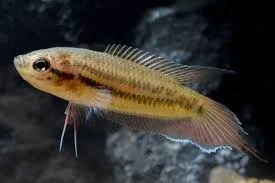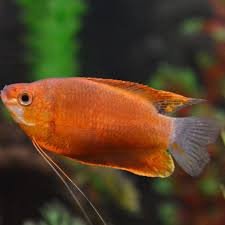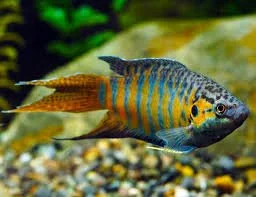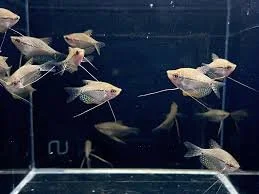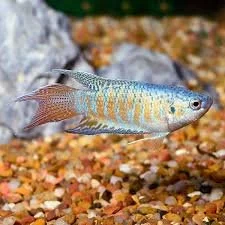 Image 1 of 1
Image 1 of 1


Dwarf Gourami
Dwarf Gouramis (Trichogaster lalius) are popular freshwater aquarium fish known for their vibrant colors and interesting behaviors. Proper care is essential to ensure their well-being. Here's a care guide for Dwarf Gouramis:
Tank Setup:
Tank Size:
A minimum tank size of 15-20 gallons is recommended for a pair or small group of Dwarf Gouramis.
Water Parameters:
Temperature: 77-82°F (25-28°C).
pH: 6.0-7.5.
Keep water hardness between 5-15 dGH.
Provide good filtration to maintain water quality.
Substrate and Decor:
Use a fine-gravel or sand substrate.
Include hiding spots, caves, and plants. Dwarf Gouramis appreciate dense vegetation.
Tank Mates:
Compatibility:
Dwarf Gouramis are generally peaceful, but avoid keeping them with aggressive or fin-nipping species.
Good tank mates include other peaceful community fish like tetras, rasboras, and peaceful catfish.
Avoid Male-Male Aggression:
If keeping more than one male Dwarf Gourami, provide plenty of hiding spots and monitor for signs of aggression. It's often better to keep only one male in a smaller tank.
Feeding:
Diet:
Offer a varied diet including high-quality flakes, pellets, and frozen or live foods like brine shrimp and bloodworms.
Dwarf Gouramis can be prone to digestive issues, so avoid overfeeding and provide a balanced diet.
Feeding Frequency:
Feed small amounts 2-3 times a day. Remove any uneaten food to maintain water quality.
Health Care:
Disease Prevention:
Quarantine new fish before introducing them to the main tank.
Maintain good water quality through regular water changes.
Watch for Signs of Disease:
Keep an eye out for any signs of illness such as lethargy, loss of appetite, or abnormal behavior. Treat promptly if needed.
Breeding:
Separate Breeding Tank:
If you want to breed Dwarf Gouramis, set up a separate breeding tank with soft, acidic water and plenty of fine-leaved plants for bubble nesting.
Bubble Nest Building:
Male Dwarf Gouramis are bubble nest builders. Provide floating plants or a styrofoam cup for the male to build a nest beneath.
Spawning Behavior:
During courtship, the male will entice the female under the bubble nest where they will release and fertilize eggs.
Fry Care:
Remove the adults once spawning is complete, as they may eat the eggs.
Feed the fry with infusoria or commercially available fry food until they are large enough to consume micropellets.
Conclusion:
Dwarf Gouramis are delightful aquarium fish with relatively straightforward care requirements. Providing a well-maintained tank, a balanced diet, and suitable tankmates will contribute to their health and longevity in captivity. Monitoring their behavior and addressing any issues promptly will help ensure a thriving aquarium environment.
Dwarf Gouramis (Trichogaster lalius) are popular freshwater aquarium fish known for their vibrant colors and interesting behaviors. Proper care is essential to ensure their well-being. Here's a care guide for Dwarf Gouramis:
Tank Setup:
Tank Size:
A minimum tank size of 15-20 gallons is recommended for a pair or small group of Dwarf Gouramis.
Water Parameters:
Temperature: 77-82°F (25-28°C).
pH: 6.0-7.5.
Keep water hardness between 5-15 dGH.
Provide good filtration to maintain water quality.
Substrate and Decor:
Use a fine-gravel or sand substrate.
Include hiding spots, caves, and plants. Dwarf Gouramis appreciate dense vegetation.
Tank Mates:
Compatibility:
Dwarf Gouramis are generally peaceful, but avoid keeping them with aggressive or fin-nipping species.
Good tank mates include other peaceful community fish like tetras, rasboras, and peaceful catfish.
Avoid Male-Male Aggression:
If keeping more than one male Dwarf Gourami, provide plenty of hiding spots and monitor for signs of aggression. It's often better to keep only one male in a smaller tank.
Feeding:
Diet:
Offer a varied diet including high-quality flakes, pellets, and frozen or live foods like brine shrimp and bloodworms.
Dwarf Gouramis can be prone to digestive issues, so avoid overfeeding and provide a balanced diet.
Feeding Frequency:
Feed small amounts 2-3 times a day. Remove any uneaten food to maintain water quality.
Health Care:
Disease Prevention:
Quarantine new fish before introducing them to the main tank.
Maintain good water quality through regular water changes.
Watch for Signs of Disease:
Keep an eye out for any signs of illness such as lethargy, loss of appetite, or abnormal behavior. Treat promptly if needed.
Breeding:
Separate Breeding Tank:
If you want to breed Dwarf Gouramis, set up a separate breeding tank with soft, acidic water and plenty of fine-leaved plants for bubble nesting.
Bubble Nest Building:
Male Dwarf Gouramis are bubble nest builders. Provide floating plants or a styrofoam cup for the male to build a nest beneath.
Spawning Behavior:
During courtship, the male will entice the female under the bubble nest where they will release and fertilize eggs.
Fry Care:
Remove the adults once spawning is complete, as they may eat the eggs.
Feed the fry with infusoria or commercially available fry food until they are large enough to consume micropellets.
Conclusion:
Dwarf Gouramis are delightful aquarium fish with relatively straightforward care requirements. Providing a well-maintained tank, a balanced diet, and suitable tankmates will contribute to their health and longevity in captivity. Monitoring their behavior and addressing any issues promptly will help ensure a thriving aquarium environment.


